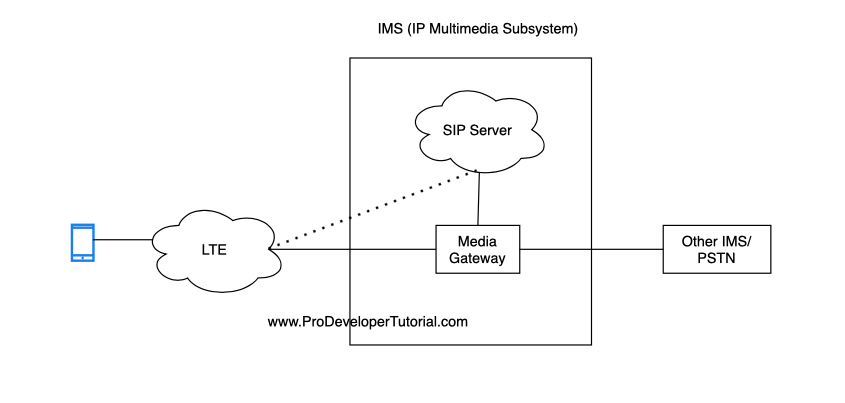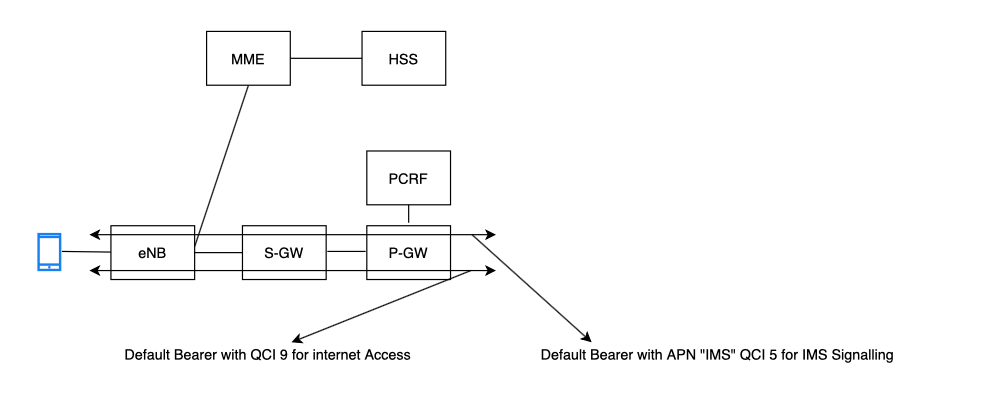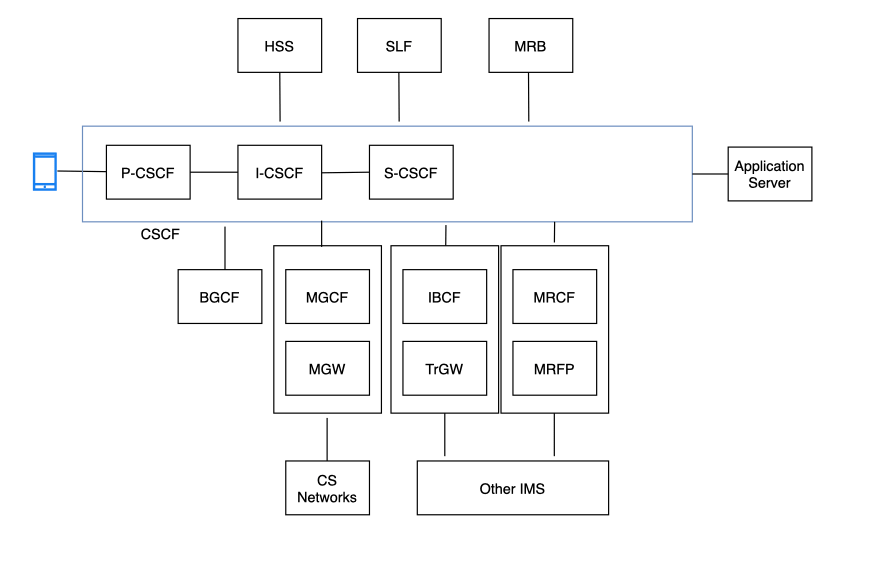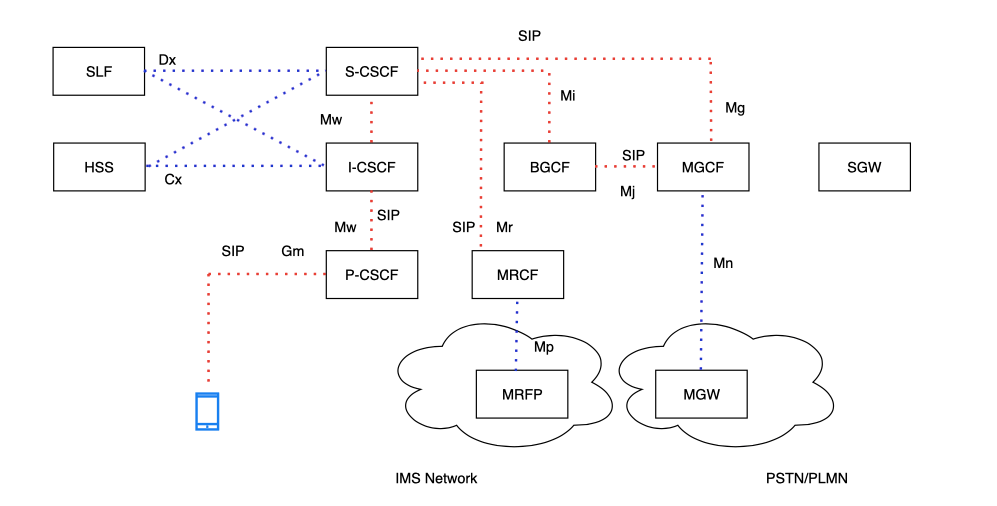In the previous chapter we had an introduction to VoLTE architecture.
In this chapter we shall see in detail about IMS Core Architecture.
A typical call will start from UE to eNB. From eNB it will go too SGW to PGW to Internet.
Internet is where IMS will reside. In other words, IMS will be connected to PGW
So LTE is used to facilitate VoLTE service. It will be handled by IMS network.
IMS Architecture Overview
From the above image, we can see that, UE is connected to LTE network.
LTE Network is connected to IMS.
More precisely PGW component of LTE is connected to P-CSCF component of IMS network.
SIP Server:
Users are going to register with SIP server, that is a part of control plane signaling.
SIP server is the stating point of VoLTE. It is used to create, modify and terminate VoIP calls.
Media information will be present in SDP part of SIP signaling.
Media Gateway:
The actual voice will flow through Media Gateway.
It is connected to other IMS Network.
It is also interconnected to circuit-switched networks.
The whole flow is called as IP-CAN (IP Connectivity Access Network). In IP-CAN, instead of LTE, there can be WIFI or other Internet Access. User needs to have a SIP UA application to connect to IP-CAN network.
Role of LTE in IMS
As you can see in the above image, if UE is supporting VoLTE, then 2 default bearers will be created.
One default bearer with QCI-9 for Internet access
Another default bearer with QCI-5 for IMS signaling
For VoLTE UE will use this default bearer to send SIP messages. It is a User Plane functionality in LTE.
PDN-GW is connected to P-CSCF using SGi interface.
For voice or video call data dedicated bearer will be created with QCI-1 or QCI-2
Overview of IMS Components
The above image will give a brief idea about high level elements involved in IMS.
IMS Core Entities
1. Media Gateways
2. HSS
3. SLF: Subscriber Location Function
4. MGCF: Media Gateway Control Function
5. BGCF: Breakout Gateway Control Function
6. CSCF: Call Session Control Function
7. MRB: Multimedia Resource Broker
We shall understand the functionality of all the elements one by one
CSCF
CSCF stands for Call Session Control Function.
It will performs all the SIP signaling operation and interacts with other IMS elements.
It does User Authentication, Call Routing among other functionality.
It has 3 different entities:
P-CSCF : Proxy CSCF
I-CSCF : Interrogator CSCF
S-CSCF : Service CSCF
Now we shall discuss all the above 3 entities in brief:
P-CSCF
1. It is the initial point of contact from EPC to IMS.
2. It forwards the registration requests received from UE to I-CSCF
3. Forwards SIP Signaling messages to S-CSCF
4. It will intercept all the signaling messages.
5. A P-CSCF is assigned to IMS terminal during registration. It can be assigned by DHCP or PDP context.
6. It belongs to visitor network.
7. P-CSCF IP address can be known to UE during EPS attach or PDN connectivity request.
8. Does SIP message compression and decompression.
I-CSCF
1. I-CSCF will communicate with HSS using Diameter Cx interface to get the location of the user and routes SIP request to its assigned S-CSCF.
2. It belongs to Home Network.
3. It is used during Registration and MT call routing.
S-CSCF
1. It will handle SIP registration requests.
2. It will intercept all the signaling messages
3. Provides routing services.
HSS: Home Subscriber Server
1. It will have database of the the subscribers.
2. It will provide subscription information.
3. It will provide data to perform authentication and authorization.
SLF: Subscription Locator Function
1. When more than HSS server is deployed in IMS network, SLF will be useful.
MGCF and MGW
MGCF and IMS-MGW:
Media Gateway Control Function and IMS-Media Gateway
1. They are responsible for control and media plane interworking to the circuit-switched network like 2G, 3G, PSTN
2. Provides trans-coding functionality
IBCF and TrGW
IBCF: Interconnection Border Control Function
TrGW: Transition Gateway
1. They are responsible for inter-working with the peer IMS network.
2. Controls one or more transition gateways.
MRF: Media Resource Function
1. Multiparty Conferencing
2. Transcoding
3. IVRS
BGCF: Break Out Gateway Control Function
1. It handles routing the call to destination network.
TAS: Telephony Application Servers
TAS are used to execute services and interacts with S-CSCF using SIP.
Some of the services it provides are:
1. Call waiting
2. Call Hold
3. Lawful Interception
4. CallID
5. Conference Calls
6. SMS
7. Presence
Below image shows all the entities with interfaces:
Reference : 3GPP 23.228



